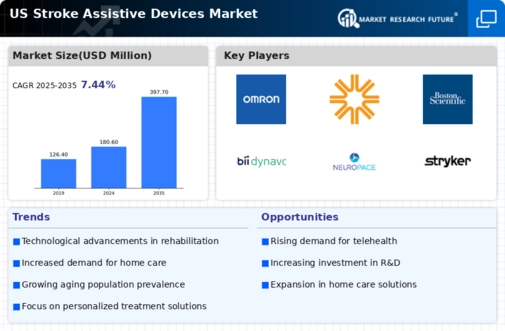The US Stroke Assistive Devices Market has become an increasingly vital sector as it addresses the needs of individuals recovering from strokes through various innovative technologies and devices. The competitive landscape demonstrates a growing interest among several players aiming to enhance patient outcomes and improve the quality of life for stroke survivors. Companies in this market focus on developing effective assistive devices that aid in rehabilitation, mobility, and support, thereby creating a dynamic and competitive environment. Factors such as technological advancements, product differentiation, and increasing incidences of stroke contribute to the competitive intensity in this market.
Additionally, partnerships, collaborations, and mergers among key industry players emerge as significant strategies to strengthen market positions and expand service offerings, fostering a robust ecosystem for stroke recovery solutions.
TheraNest is a notable player within the US Stroke Assistive Devices Market, establishing a strong presence through its user-friendly, innovative solutions tailored to healthcare professionals working with stroke patients. The company focuses on providing a comprehensive platform that aids in maintaining the continuity of care through advanced reporting and tracking capabilities. TheraNest's strengths lie in its commitment to enhancing rehabilitation outcomes by equipping therapists with effective tools to manage and monitor patient progress. Their adaptability and focus on the unique needs of therapists and patients ensure that they remain at the forefront of assistive technology development.
The emphasis on user experience and feedback further assists TheraNest in fine-tuning its offerings, positioning them as a trusted name in the industry dedicated to promoting stroke recovery success.
Omron Healthcare is another key player in the US Stroke Assistive Devices Market, known for its extensive range of products aimed at stroke prevention and management. The company is recognized for its innovative technologies, including blood pressure monitors and health management devices that provide vital information necessary for stroke care. Omron's market presence is characterized by strong distribution networks and collaborations with healthcare providers, enhancing its reach and accessibility to consumers. The company's strengths lie in its commitment to research and development, ensuring that its products are equipped with the latest technological advancements to better serve patients.
Omron Healthcare has consistently invested in strategic mergers and acquisitions, broadening its portfolio and positioning itself as a leader in the assistive devices market for stroke care in the United States. Their focus on patient-centric solutions and engagement through digital health platforms further enables them to maintain a competitive edge, aligning with the evolving needs of stroke survivors and healthcare professionals alike.



















